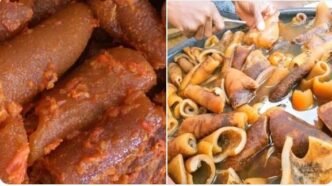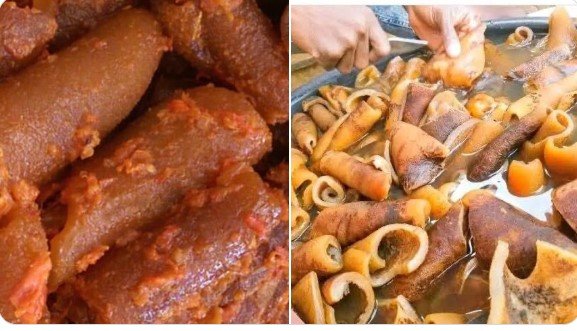In a striking alert, the federal government of Nigeria has warned that the continued consumption of “ponmo”—the locally produced animal hides and skins eaten as a delicacy—is jeopardising the country’s leather industry, now estimated to be worth around US$5 billion.
At a national campaign event in Abuja, the Director-General of the Raw Materials Research & Development Council (RMRDC), Prof. Nnanyelugo Ikemounso, delivered a blunt message: by diverting hides from industrial use into the food chain, Nigeria is depriving its leather sector of the raw materials it needs for tanning and manufacturing.
What the Government Says
Prof. Ikemounso outlined key figures. He stated that in 2024 the Nigerian leather goods market was valued at US$2.79 billion, with projections indicating it could grow to US$4.96 billion by 2033. He warned that the continuous diversion of hides into ponmo consumption could derail this growth trajectory.(Punch)
From an economic and industrial standpoint, he stressed, cowhides are among Nigeria’s most valuable raw materials. The country possesses a vibrant leather industry with enormous potential for job creation, foreign exchange earnings and contributions to GDP. Yet the ongoing practice of diverting hides for food consumption is undermining this potential.(The Guardian Nigeria)
Prof. Ikemounso underscored that the global leather value chain is estimated to be worth between US$420 billion and US$1 trillion, and that Nigeria, with the right policy direction, infrastructure and raw-material availability, can significantly increase its share of that market.(The Guardian Nigeria)
Importantly, he clarified that the campaign is not designed to undermine cultural or dietary choices, but to reposition hides and skins for industrial use for national benefit.(The Guardian Nigeria)
Why This Matters, Deep Dive
Economic Value and Opportunity Lost
When hides and skins are consumed rather than processed industrially, the country misses out on a value-chain with far greater potential. Leather manufacturing – from raw hide to finished goods such as shoes, bags, belts – yields significantly more value than simple consumption of hides as a food item. By diverting raw hides to the food market, Nigeria sacrifices job creation, foreign-exchange earnings and high-value export opportunities.
Raw-Material Scarcity and Industry Weakness
Leather manufacturing begins with quality raw hides and skins. When those inputs are diverted or degraded (through poor processing or unsafe handling for food use), tanneries and finished-goods makers face higher costs, lower yields, lower quality output and reduced competitiveness internationally. The government fears that continuing the current trend will weaken the tanning sector and undermine Nigeria’s ability to scale up its leather goods industry.(Punch)
Health and Nutritional Concerns
The government’s critique of ponmo is not purely economic. In his remarks, the Director-General noted that from a nutritional standpoint, ponmo offers very little: it is largely collagen and contains negligible protein or micronutrients.(The Guardian Nigeria)
More significantly, he raised concerns that many hides processed for consumption are preserved and treated with industrial-grade chemicals, including formalin and diesel – substances not intended for food use. These practices, he stated, carry serious health risks including organ damage and cancer.(The Guardian Nigeria)
Industry Growth Forecasts at Risk
With the local leather goods market projected to double or more by 2033, the diversion of hides threatens to derail those forecasts. If hides are channelled away from industry, growth will stall; firms lacking raw materials may reduce production or shut down; exports may stagnate and jobs may be lost. The value of US$5 billion cited for the industry hinges on steady raw-material flows and processing capacity.(Punch)
Challenges & Resistance — What Could Block Progress?
While the government sees a clear risk, changing longstanding consumption patterns will not be easy.
- Cultural and affordability factors: Ponmo is entrenched in many Nigerian diets; it is culturally familiar and often cheaper than many alternatives. Any campaign perceived as targeting consumption may face backlash from consumers and traders.
- Informal market dynamics: Much of the ponmo trade is informal and lacks regulatory oversight. Redirecting hides toward industrial use requires reorganising supply-chains, incentivising traders, and perhaps regulating practices at slaughterhouses and hide-markets.
- Industrial infrastructure gaps: Even if raw hides become more available, Nigeria’s leather industry must have capacity to absorb them. Issues such as lack of power supply, obsolete tanning equipment, low investment, and limited access to chemicals and finishing technologies have hampered progress previously. Without addressing these, raw-material availability alone will not guarantee growth.
- Enforcement and incentives: The government campaign may face enforcement issues unless there are alternative pathways for hide-traders and food-market actors whose livelihoods depend on the ponmo trade.
What’s Being Done — Policy Response
In response, the federal government and industry stakeholders are pursuing a number of actions:
- Awareness and advocacy: The national campaign aims to raise awareness among consumers, butchers, hide-traders and industry players about the industrial value of hides and the health risks of untreated ponmo.
- Regulatory measures: Officials are exploring regulatory instruments to restrict consumption of hides that should be industrial-grade, or to improve traceability, processing standards and market classification between hides for food and hides for industry.
- Value-chain development: There is increased focus on establishing mini-tanneries across the states, upgrading existing tanneries, and providing incentives for the leather sector so that raw hides can be processed locally into higher-value goods, reducing dependence on imports.
- Collaboration with stakeholders: The government is engaging slaughterhouses, hide-market operators, butchers, traders and processors to develop supply-chain protocols that channel hides appropriately, prioritising industrial uptake over food consumption where possible.
Broader Implications for Nigeria’s Economy
This issue transcends mere food preference. The strategic implications are significant:
- Diversification of economy: As Nigeria seeks to move beyond oil-dependence, strengthening sectors such as leather manufacturing offers a pathway to job creation, export earnings and industrialisation. Redirecting hides from consumption to industry is consistent with that.
- Value addition: Rather than exporting raw hides or limiting hides to low-value domestic consumption, processing hides into finished or semi-finished leather goods adds value locally — supporting manufacturing, design, branding and export.
- Improved sustainability: Using locally-sourced hides more effectively reduces reliance on imported raw materials and imported finished leather goods — supporting self-sufficiency and economic resilience.
- Health and social benefits: Reducing consumption of poorly processed and chemically treated hides may lower public-health burdens, reduce exposure to toxins and improve food-safety outcomes.
- Job creation and exports: A thriving leather sector can employ thousands of Nigerians — from hide-collection and processing, to tanning, finishing, manufacturing of leather goods, branding and export logistics.
Looking Ahead: What Needs to Happen
For this warning to translate into action and change, several conditions need to be met:
- Clear policy direction and enforcement: The government must follow through with regulations, market-classification systems for hides, processing standards and enforcement mechanisms to deter diversion of hides into consumption when they should serve industry.
- Infrastructure investment: Upgrading tanneries, providing reliable power, access to modern tanning chemicals, shoring up supply-chain logistics, training labour and supporting leather-goods manufacturing capacity will all be crucial.
- Supply-chain realignment: Slaughterhouses and hide markets must be integrated with industrial pathways — with incentives for butchers, traders and processors to channel hides into the leather sector instead of consumption.
- Public-education campaigns: Consumers must understand why this matters: that redirecting hides helps the economy, job creation, export potential and national development—and that consumption of poorly processed hides carries health risks.
- Alternative income pathways: For traders and market players currently in the ponmo value-chain, alternative incomes or transition pathways will ease the adjustment and ensure the policy change is equitable and socially acceptable.
- Monitoring and data-collection: Accurate data on slaughter numbers, hide diversion, tanneries’ capacity, manufacture of leather goods, exports and imports will be essential to track progress and hold stakeholders accountable.
Conclusion
The federal government’s warning over ponmo consumption is not mere rhetoric—it signals a real structural vulnerability in Nigeria’s industrial landscape. By diverting hides away from manufacturing into consumption, the country is forfeiting the chance to expand its leather industry—a sector valued at approximately US$5 billion—and tap into global markets worth hundreds of billions of dollars.
To reverse this trajectory, Nigeria must act decisively: protect the hide-value chain, develop industrial capacity, align supply-chains, educate the public, and build the bridge between food culture and industrial opportunity. If this campaign succeeds, what many see as a humble delicacy could become a key raw material that drives export-oriented manufacturing, thousands of jobs, and stronger economic growth.
In short: redirecting hides from the soup pot to the tannery could be one of Nigeria’s most important industrial moves yet—and the cost of inaction may be far greater than many realise.












